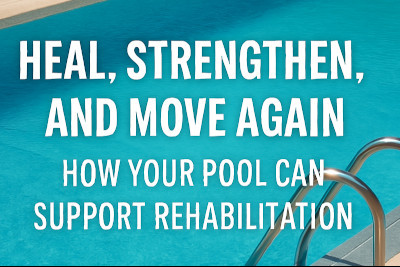Why Pools Are Perfect for Rehab
Fri, Mar 28th, 2025
Your pool isn’t just for fun or relaxation—it can be a powerful tool for healing. Here’s why water makes such a difference:
- Buoyancy: Water supports a portion of your body weight, easing the strain on joints, bones, and muscles. This makes movement easier and less painful—especially for those recovering from orthopedic injuries, strokes, or surgeries
- Resistance: Water provides natural, uniform resistance in all directions. That means every movement becomes a gentle workout that helps tone muscles and rebuild strength without the need for weights.
- Hydrostatic Pressure: This refers to the pressure water exerts on your body, which can reduce swelling, improve circulation, and help with pain management.
- Reduced Risk of Re-injury: Because exercises are lower impact in the pool, there’s a decreased chance of aggravating existing injuries or overstraining healing tissues.
Enhancing Flexibility in the Pool
Flexibility plays a vital role in recovery. Limited range of motion can lead to stiffness, discomfort, and even new injuries if not properly addressed. Luckily, your pool offers a gentle, supportive environment for stretching and movement.
Try these simple water-based exercises to improve flexibility:
- Water Walking or Jogging: In waist- or chest-deep water, walk forward, backward, and side to side. You’ll work major muscle groups, improve balance, and stretch gently as you go. The resistance helps activate muscles without putting pressure on joints.
- Arm Circles: In shoulder-deep water, extend your arms out and make slow, controlled circular movements. This improves shoulder flexibility and can help rebuild strength after arm or upper back injuries.
- Leg Swings: Holding onto the pool edge for support, swing one leg forward and backward, then side to side. This promotes hip mobility and is great for regaining range of motion in the lower body.
Start slow and stay within a comfortable range of motion. Over time, you can increase reps or duration as flexibility improves.
Rebuilding Strength with Water-Based Workouts
Regaining lost strength is a common goal in rehab, and your pool makes it easier and safer to do so. The water cushions your movements while still challenging your muscles through resistance.
A few go-to strength exercises include:
- Water Push-Ups: Stand facing the pool wall with your hands on the edge, shoulder-width apart. Bend your elbows and lean in toward the wall, then push back to the starting position. This helps strengthen the arms, shoulders, and chest.
- Leg Lifts: In waist-deep water, lift one leg to the front, side, or back while keeping your posture tall and stable. Switch legs and repeat. This builds strength in your hips and legs, supporting balance and daily function.
- Bicep Curls with Water Weights: Use foam dumbbells or resistance paddles. Curl the weights toward your shoulders, then lower. Water resistance will activate muscles more than you'd expect—without the need for heavy gym equipment.
Start with a few repetitions and slowly build up. If you feel pain, stop and modify or rest.
Boosting Endurance in the Water
Endurance and cardiovascular fitness are key parts of the healing process—especially if your recovery has kept you less active than usual. Your pool is a great place to safely improve stamina.
Try these exercises:
- Aqua Jogging: In deeper water, wear a floatation belt and jog in place or across the pool. This gets your heart rate up without straining your joints.
- Flutter Kicks: Hold onto the edge of the pool or a kickboard and kick your legs behind you. This simple movement helps strengthen your core and legs while building cardiovascular endurance.
- Treading Water: In the deep end, move your arms and legs to stay afloat. It’s a full-body workout that improves stamina, coordination, and confidence in the water.
Start with short intervals (like 30 seconds of activity followed by rest), and gradually increase duration as your endurance builds.
Safety First: Smart Tips for Pool-Based Rehab
Water-based rehab is incredibly beneficial—but like all exercise, it should be approached with care. Here are a few key safety reminders:
- Talk to Your Doctor First: Always get medical clearance before starting new exercises. Your provider can offer personalized advice based on your condition.
- Start Slowly: Begin with gentle movements and build up intensity and duration over time. Overdoing it early can hinder progress or cause setbacks.
- Use Supportive Equipment: Floatation belts, water dumbbells, pool noodles, or handrails can help you stay balanced and safe during exercise.
- Stay Hydrated: Just because you’re in the pool doesn’t mean you’re not sweating. Drink water before and after your session.
- Warm Up and Cool Down: A few minutes of gentle walking or stretching at the beginning and end of your session will reduce soreness and support recovery.
Let Your Pool Be Part of the Healing Process
Rehabilitation doesn’t have to feel like a chore. With the help of your own backyard pool, you can create a peaceful, supportive space to move again—gaining strength, flexibility, and confidence with each session.
If your pool could use a little love before becoming your personal rehab oasis, Sweetwater Pool Service is here to help. From maintenance to upgrades, we make sure your pool is always ready when you are.
Ready to take the plunge toward better health? Let your pool be more than just a summer hangout—it could be the key to your recovery journey.
Contact Sweetwater Pool Service to keep your pool clean, healthy and the pool equipment running at full capacity.



